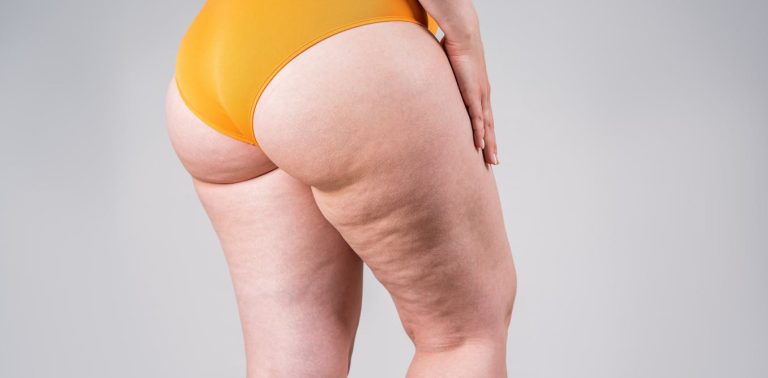Although 90% of women have cellulite, we do not yet see it represented as a normal anatomical feature in popular culture. In Greta Gerwig’s 2023 Hollywood blockbuster, for example, Stereotypical Barbie, played by Margot Robbie, develops dimples on her upper thighs as part of her existential crisis – along with other human flaws like bad breath, flat feet and overwhelming thoughts of death.
When stereotypical Barbie asks wisecracking Weird Barbie doll what dimples are, she explains, “That’s cellulite. This will spread everywhere. Then you start to get sad, cloudy and complicated.” Barbie’s perfect smooth plastic perfection is tarnished.
Despite its prevalence, therefore, cellulite has been constructed as a defect that needs correction. Consumers, it seems, agree, especially when fed his diet photoshop smoothes the skin of models, social media influencers – and Hollywood stars.
Cellulite is usually found in areas that have greater amounts of subcutaneous fat, when the fat deposits are pushed through the connective tissue under the skin, leading to a lumpy appearance. It’s usual, usually painless and harmless.
Human skin is the largest organ of the body, consisting of three layers. On the surface, the skin acts as our first line of defense against the environment. This outermost, impermeable layer is made up of cells that are constantly being renewed and shed, protecting our body from external elements.
Beneath the epidermis is the dermis, a strong layer containing fibroblasts, the cells responsible for producing essential proteins such as collagen and elastin. These proteins provide structure and elasticity, contributing to the skin’s strength and elasticity.
Deeper still is the hypodermis, also known as the subcutaneous layer. This layer is rich in adipose tissue – consisting mainly of fat, which plays a key role in protecting and insulating the body, as well as storing fat that can be used when needed. Beneath these three layers of skin, there is muscle. Running from the muscle to the dermis it is connective tissue bandswhich holds the adipose tissue in “pockets”.
Cellulite does not affect health, although some people report that it affects theirs self-esteem and body image but this has more to do with societal pressure on women to be physically perfect – or to spend money, time and energy trying to be as close to perfect as possible.
Cellulite, then, has become big business for the beauty industry. In view of the summer especially, companies will promote all kinds of products from creams and serums to gadgets and pills, all aimed at creating perfectly smooth ends. The most popular question seems to be, “Do these treatments work?” but as an anatomist I think the most pressing question is, “Why are healthy women’s bodies considered something to treat, cure, or fix?”
The beauty and wellness industry has long capitalized on societal beauty standards. The idea that cellulite is undesirable and must be corrected has been perpetuated since Vogue magazine was the first English-language magazine to use the term “cellulite”, introducing the concept to thousands of women. This marketing strategy exploits the insecurities of consumers, especially women, and promotes the endless search for “perfection” for bodies that have normal anatomical variation.
By defining cellulite as a condition in need of treatment, companies can sell a wide range of products and services, bolstering celebrity endorsements, which lend credibility and aspiration to pseudo-medical “smoothing” products. However, there is limited scientific evidence to support the effectiveness of these supplements in treating cellulite. Actually, the first scientific paper on cellulite, published in 1978, called it “the so-called cellulite: the invented disease.”
Recent product releases include, Lemme Smooth, Kourtney Kardashian-Barker’s latest addition to her line of vitamins and supplements. The product’s promotional materials claim that the capsule “visibly reduces cellulite in 28 days.” But what does science tell us?
Supplements like Lemme Smooth claim to improve skin texture and reduce cellulite from within. The Kardashian-Barker supplement contains a blend of French cantaloupe cantaloupe, hyaluronic acid, chromium and vitamin C among other ingredients. The body’s ability to absorb and use these ingredients in a way that affects cellulite is still a matter of debate.
There are indications that ingestion of hyaluronic acid can migrate into the skin, stimulating collagen production within the dermis – and vitamin C has been shown to thicken the surface layer of the skin. However, the lack of standardization in trials for the use of these ingredients in the treatment of cellulite means that it is not yet clear whether they will have significant effect.
Other products marketed to reduce the appearance of cellulite include topical creams and lotions, which contain ingredients such as caffeine, retinol and herbal extracts. Cosmetic products are not able to penetrate the skin enough to significantly affect the underlying fatty deposits and connective tissue.
Certain invasive treatments, such as laser therapy, subcision and acoustic wave therapy may provide more promising results. These procedures work by breaking down the connective tissue bands that cause dimpling and stimulate collagen production in the dermis to improve skin elasticity. While these methods can be more effectivethey are often expensive, require many sessions to achieve results – and are not without risk.
Maintaining a healthy diet, drinking plenty of water and regular physical activity can help improve the overall appearance of the skin and reduce the visibility of cellulite. Losing weight and strengthening the muscles in your legs, buttocks and abdomen can make cellulite less noticeable, but it won’t disappear completely.
The bottom line, though, is that cellulite doesn’t need treatment. It’s a normal anatomical variation that has turned into a condition that leads to a lucrative market for treatments which do not exist.
My top expert tip ahead of summer? Be careful with claims from cosmetic companies and save money.
The Conversation has reached out to the Lemme Live brand for comment.

